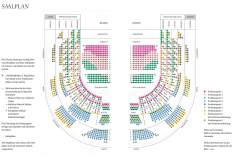Cavalleria Rusticana |Pagliacci with Jonas Kaufmann
Mo | Tu | We | Th | Fr | Sa | Su |
Synopsis
CAVALLERIA RUSTICANA
Turiddu was engaged to Lola before he was called up for military service. When he returns home, he is disappointed to discover that Lola has become the wife of the wealthy Alfio. Turiddu tries to console himself with Santuzza..
Easter morning in a Sicilian village.
Turiddu sings a serenade for Lola, with whom he has reconnected. Spring brings joy to the villagers. Santuzza, driven by inner turmoil, looks for Turiddu at his mother Lucia's, who runs a bar in the village square. Alfio, who has been away on business, returns and sings of his wife's fidelity. Easter bells call the villagers to the morning service.
Santuzza, who feels sinful because of her relationship with Turiddu and has therefore remained outside the church, suspects his infidelity and confides her worries to Turiddu's mother. He is confronted and resorts to excuses. But when Lola passes by, he forgets Santuzza and her accusations, pushes her away and runs after Lola. Santuzza curses him. Deeply offended and hurt in her honor, she tells Alfio about his wife's adulterous relationship with Turiddu. Alfio's anger leads to an oath of revenge. Only now does Santuzza realize in despair what a fatal development she has initiated.
-Intermezzo sinfonico-
After church, Turiddu invites everyone to a traditional drink. He also offers Alfio a cup. He refuses curtly. Turiddu realizes that Alfio knows about the adultery. A duel is demanded according to Sicilian ritual. In his burgeoning fear of death, Turiddu asks for his mother's blessing and asks her to protect Santuzza. He then faces the duel at the agreed location. The cry "Turiddu has been murdered!" ends the tragedy.
PAGLIACCI
Tonio, a comedian who plays Taddeo in the Commedia, takes the place of the poet as prologue and explains the play to the audience in programmatic outline: the author, even though he uses masks, wants to be nothing other than a painter this time, whose subject is real life. However, one should not linger over the dance of masks, but immerse oneself in the souls of people.
The action takes place on the day of the Assumption (August 15). Canio's troupe of comedians arrives, warmly welcomed by the townspeople. In addition to Nedda, the principal's wife (in the Commedia Colombina), Beppe (in the Commedia Arlecchino) and Tonio are also part of the troupe. Canio (in the Commedia Pagliaccio) announces his performance for tonight. When Tonio tries to help Nedda off the wagon, Canio jealously pushes him away. The comedians are invited to a drink. Someone jokes that Tonio is only staying behind to have a rendezvous with Nedda. Canio reacts violently: he may play the cuckolded husband in the comedies, but in real life he would not tolerate infidelity.
Bells call for the evening church service. Nedda is disturbed by Canio's barely veiled threat. She feels constricted by his jealousy, wants to escape her invisible cage and be as free as a bird... Tonio has overheard them. He wants to force his love on Nedda, but is scornfully rejected. Full of rage and threatening revenge, he makes his escape. Silvio, a young farmer with whom Nedda has fallen in love, appears. He implores her to leave Canio and flee with him tonight. After some initial hesitation, she agrees, unaware that Tonio has overheard them both and hastens to summon Canio from the nearby osteria.
Just as Nedda is saying goodbye to her lover, Canio rushes out, furious with jealousy. Silvio manages to escape unrecognized. Canio's rage now turns against Nedda. He threatens her with his knife and demands that Nedda reveal the name of her boyfriend. But she remains silent. Beppe is able to snatch the knife from Canio and prevent the worst from happening. The audience is about to appear to watch the performance. Canio struggles to calm down and gets ready for the performance.
Shortly before the Commedia begins: Tonio beats the big drum and the spectators, including Silvio, arrive expectantly. Nedda, who collects the money, warns her lover of Canio's jealousy. The game between Colombina, Arlecchino, Taddeo and Pagliaccio begins. When Nedda, in her role as Colombina, shouts the same words she shouted at Silvio to the serenade singer Arlecchino as they say goodbye, Canio sees the game and reality become blurred.
Outraged with jealousy, he demands to know the name of Nedda's lover on stage. Colombina/Nedda tries to resume the play, but Canio becomes increasingly threatening. The audience also begins to suspect that this is about more than just theater. When Nedda stubbornly remains silent, Pagliaccio/Canio stabs her and kills her. Her cry for help, addressed to Silvio, results in Canio turning to the man who has come running and fatally hitting him too. - La commedia è finita" - The play is over.
CAVALLERIA RUSTICANA - 75 MIN
INTERMISSION - 25 MIN
PAGLIACCI - 75 MIN
Program and cast
Cavalleria Rusticana / Pagliacci
Santuzza: Elīna Garanča
Turiddu: Jonathan Tetelman
Lucia: Elena Zaremba
Alfio: Adam Plachetka
Musical direction: Nicola Luisotti
Direction, stage and costumes: Jean-Pierre Ponnelle
Pagliacci
Canio (Pagliaccio): Jonas Kaufmann
Nedda (Colombina): Maria Agresta
Tonio (Taddeo): Adam Plachetka
Beppo (Arlecchino): Jörg Schneider
Silvio: Stefan Astakhov
Musical direction: Nicola Luisotti
Direction, stage and costumes: Jean-Pierre Ponnelle
Vienna State Opera
Public Transport
Subway lines: U1, U2, U4
Trams: 1, 2, D, J, 62, 65
Buses: 59A
Local Railway: Badner Bahn
Stops: Karlsplatz / Opera
Taxi stands are available nearby.
Parking
Parking is only € 6, - for eight hours!
The Wiener Staatsoper and the ÖPARK Kärntner Ring Garage on Mahlerstraße 8, under the “Ringstraßengalerien”, offer the patrons of the Vienna State Opera a new, reduced parking fee. You can park in the Kärntner Ring Garage for up to 8 hours and pay only a flat fee of € 6, -. Just validate your ticket at one of the discount machines inside the Wiener Staatsoper. The normal rate will be charged for parking time greater than 8 hours. The validation machines can be found at the following coat checks: Operngasse, Herbert von Karajan-Platz, and the right and left and balcony galleries.
Important: In order to get the discount, please draw a ticket and do not use your credit card when entering the garage!
After devaluing your ticket in the Wiener Staatsoper you can pay comfortably by credit card or cash at the vending machines.
The machines accept coins and bills up to 50.- Euro. Parking time longer than 8 hours will be charged at the normal rate.
History
The structure of the opera house was planned by the Viennese architect August Sicard von Sicardsburg, while the inside was designed by interior decorator Eduard van der Nüll. It was also impacted by other major artists such as Moritz von Schwind, who painted the frescoes in the foyer, and the famous "Zauberflöten" (“Magic Flute”) series of frescoes on the veranda. Neither of the architects survived to see the opening of ‘their’ opera house: the sensitive van der Nüll committed suicide, and his friend Sicardsburg died of a stroke soon afterwards.
On May 25, 1869, the opera house solemnly opened with Mozart's Don Giovanni in the presence of Emperor Franz Joseph and Empress Elisabeth.
The popularity of the building grew under the artistic influence of the first directors: Franz von Dingelstedt, Johann Herbeck, Franz Jauner, and Wilhelm Jahn. The Vienna opera experienced its first high point under the direction of Gustav Mahler. He completely transformed the outdated performance system, increased the precision and timing of the performances, and also utilized the experience of other noteworthy artists, such as Alfred Roller, for the formation of new stage aesthetics.
The years 1938 to 1945 were a dark chapter in the history of the opera house. Under the Nazis, many members of the house were driven out, pursued, and killed, and many works were not allowed to be played.
On March 12, 1945, the opera house was devastated during a bombing, but on May 1, 1945, the “State Opera in the Volksoper” opened with a performance of Mozart's THE MARRIAGE OF FIGARO. On October 6, 1945, the hastily restored “Theaters an der Wien” reopened with Beethoven's FIDELIO. For the next ten years the Vienna State Opera operated in two venues while the true headquarters was being rebuilt at a great expense.
The Secretary of State for Public Works, Julius Raab, announced on May 24, 1945, that reconstruction of the Vienna State Opera would begin immediately. Only the main facade, the grand staircase, and the Schwind Foyer had been spared from the bombs. On November 5, 1955, the Vienna State Opera reopened with a new auditorium and modernized technology. Under the direction of Karl Böhm, Beethoven’s FIDELIO was brilliantly performed, and the opening ceremonies were broadcast by Austrian television. The whole world understood that life was beginning again for this country that had just regained its independence.
Today, the Vienna State Opera is considered one of the most important opera houses in the world; in particular, it is the house with the largest repertoire. It has been under the direction of Dominique Meyer since September 1, 2010.

 EN
EN DE
DE IT
IT FR
FR ES
ES RU
RU JP
JP RO
RO
 Seating plan
Seating plan